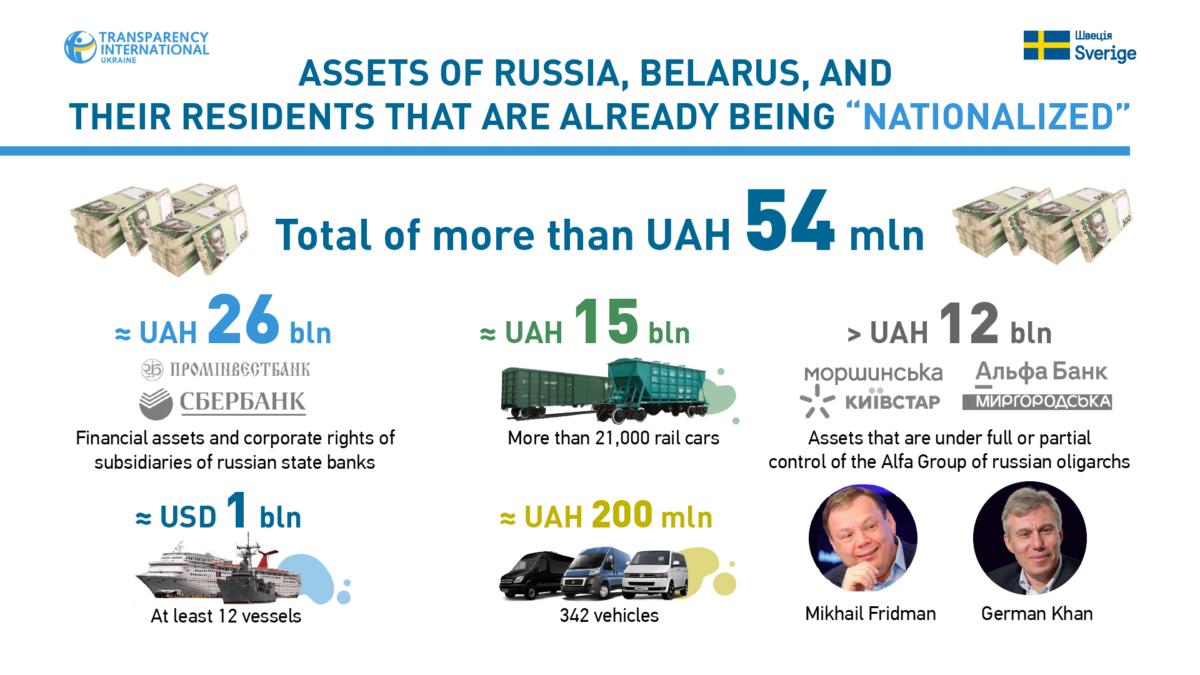

On May 12, the Verkhovna Rada approved a presidential decree launching the so-called nationalization of russian assets in Ukraine. In fact, it is rather confiscation because according to our Constitution, forced alienation of property provides for the payment of compensation to previous owners. In the case of russian property in Ukraine — no compensation is provided.
However, whatever you call it, the first russian property — corporate rights and financial assets of the Ukrainian subsidiaries of the russian state-owned MR Bank and Prominvestbank — will be transferred to the National Investment Fund of Ukraine.
This is just the beginning of a large-scale campaign. In this text, we are explaining who and how will look for this property in Ukraine, and how it will be seized.
Who is searching for russian assets?
The law does not clearly define who has to search for and identify russian assets. It is known that the Prime Minister instructed the Ministry of Economy to form a list of property rights objects of the russian federation and its residents. It will do this based on proposals that will be provided to it by the central executive authorities, regional state/military administrations, as well as other state bodies. The list is still being formed, but some state bodies have begun to cover their achievements publicly in the field of search for russian property.
- One of the first to report the identified russian assets was the NACP. In mid-March, its head toldabout a list of 21 companies owned by russia in Ukraine. It includes, in particular, the already mentioned Prominvestbank and MR Bank, as well as Energomashspetsstal, International Consortium for the Management and Development of the Gas Transportation System of Ukraine, Lysychansk Oil Investment Company, Gazprom Zbut Ukraina, Yuzhniigiprogaz, the 13th Shipyard of the Black Sea Fleet, and others.
The Agency, together with the Prosecutor General’s Office, the Ministry of Foreign Affairs, the Security Service of Ukraine, the NABU, the National Police, and the State Financial Monitoring Service, is a member of the Task Force UA interdepartmental working group on search and seizure of the russian assets. Together, they are looking for russian assets not only in Ukraine, but also abroad.
Within the framework of this project, the NACP has launched a Portal where everyone can report the assets of persons involved in the aggression of russia against Ukraine.
- Immediately after the invasion of the rf, the National Bank of Ukrainerevoked the licenses of the International Reserve Bank and Prominvestbank, which were under the control of the aggressor state, and invited the government to “nationalize” their assets. The NBU estimated them at UAH 26 bln. It is important that part of the assets are also the rights of claim of these banks against the debts of Ukrainian companies, including Ukrzaliznytsia, Electrovazhmash plant, state enterprises “Artem” and “Zorya”-“Mashproyekt,” in the amount of UAH 14.6 bln.
However, the NBU does not plan to “nationalize” Alfa-Bank, whose shareholders are russian businessmen who have fallen under EU sanctions. Initially, russians were to be obliged to transfer their shares to other, unrelated persons. However, eventually, the NBU determined a trustee to whom their voting rights were transferred. Sanctioned owners, in turn, promised to recapitalize the bank for USD 1 bln.
- The Bureau of Economic Security has searched for and seized over UAH 30 bln worth of assets of the rf and the Republic of Belarus. These include:
– corporate rights and assets of the Mining and Enrichment Plant, which extracted titanium-containing raw materials;
– 17,800 rail cars with an estimated value of UAH 15 bln;
– more than 160 units of cars and special equipment for UAH 220 mln;
– assets of the companies of the russian oligarch Mikhail Friedman, through which he owns the above-mentioned Alfa-Bank, for a total amount of more than UAH 12.4 bln.
The Bureau also found 342 pieces of equipment (cars and trucks, special and agricultural machinery) belonging to enterprises from russia and Belarus.
- The State Bureau of Investigationalso searches for and initiates the forced alienation of russian and Belarusian property. As of mid-May, the agency found:
– more than 3,500 railway cars;
– 8 cargo vessels and 2 tankers for UAH 1 bln;
– 27 trucks;
– metallic blanks and products for UAH 93 mln;
– 238 units of household appliances for UAH 1.9 mln;
– 276,000 kg of agricultural fertilizers for more than USD 151,000.
The SBI estimates all the identified property at tens of millions of dollars.
Recently, it has become known that the SBI was investigating the fact that a group of russians close to the Kremlin had appropriated five energy distribution enterprises: Khersonoblenergo, Kirovogradoblenergo, Zhytomyroblenergo, Rivneoblenergo, Chernivtsioblenergo. In addition to these critical infrastructure facilities, the group controls the Zaporizhzhia-based Dniprospetsstal and Premier Hotels & Resorts, including the five-star Premier Palace in Kyiv and Premier Hotel in Odesa.
- The ARMAis searching for russian assets within the framework of criminal proceedings related to the war, both in Ukraine and abroad. These are industrial enterprises, corporate rights, movable and immovable property worth more than USD 1 bln. Read more about the work of the ARMA during the war in our material.
- The SBUtogether with the Prosecutor General’s Office blocked the activities of the energy company, which was part of the russian Rosneft group. The funds of this company in the amount of UAH 23 mln were seized, and proposals for the nationalization of the property of the blocked enterprise were referred to the Cabinet of Ministers.
- However, it is not only state bodies that help to identify the property of the rf in Ukraine. Back in March, Ukrzaliznytsiaidentified 15,000 rail cars belonging to russia and companies associated with it, and offered to confiscate them.
In total, according to YouControl, approximately 14,000 active Ukrainian companies have citizens or residents of the russian federation among the owners, founders, or ultimate beneficiaries, and more than 270 Ukrainian companies are co-owners of russian enterprises.
How assets will be seized
To date, Ukraine has four legislative mechanisms for the seizure and confiscation of the assets of the rf and its residents.
- Confiscation of property on the basis of a court decision. The current Criminal Code defines several criminal offenses for which this type of punishment is provided. For example, collaborative activities, assistance to the aggressor state, justification of the armed aggression of the rf against Ukraine. However, confiscation is possible only if it is established that the owner of the property is guilty of committing such a criminal offense. So, it will not be possible to seize all russian assets in this way.
- Requisition in accordance with the Law “On the Transfer, Forced Alienation or Seizure of Property under Legal Regime of the Martial Law or State of Emergency” in force before the war. We have already explained what the requisition is, and how it is applied. This mechanism has a significant disadvantage — it provides for mandatory reimbursement of the value of the seized property. We believe that this is unacceptable in the case of the aggressor state and its associates.
- The mechanism provided by the Law “On the Basic Principles of Forced Seizure of Property Rights of the Russian Federation and its Residents in Ukraine,” adopted during the war. It will be followed by the seizure of corporate rights and financial assets of the International Reserve Bank and Prominvestbank. However, it has some risks. In particular, it does not determine the responsible body that will carry out the search and identification of russian assets. In addition, it contradicts the Constitution of Ukraine. Consequently, former owners of property may appeal against its confiscation in international courts. However, as one of the MPs noted before the adoption of this law, “do not be ashamed of the mechanisms, do not limit yourself.”
- In parallel with the approval of the Presidential Decree on the forced seizure of the first assets of the rf, draft law 7194 entered into force. It defines a new legal mechanism of confiscation — the application of sanctions in the form of a recovery to the state income by a court decision. Despite questions about the distribution of functions for the implementation of this mechanism among institutions and its compliance with the standards of the European Court of Human Rights, the draft law provides for a more effective procedure for recovery to the state income than mechanism No.3.
Confiscation is a justified response to the actions of the aggressor state. Funds from the sale of russian assets can be channeled to the army, to the restoration of destroyed infrastructure, and compensation to the victims of the crimes of the rf. At the same time, it is important that confiscation does not create problems for Ukraine in the future in the legal aspect. Forced dispossession shall be an exceptional measure which shall be reasonable and proportionate in the particular circumstances. Therefore, it is essential that the assets of the rf and its residents are seized according to a procedure that will be consistent with the provisions of Ukrainian legislation, as well as comply with international legal standards.
This material was written in collaboration with Andriy Shvadchak and Kyryl Sydorchuk.







